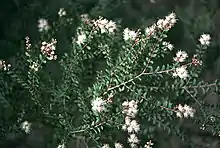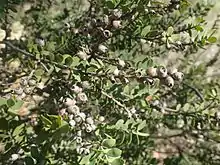| Melaleuca cheelii | |
|---|---|
 | |
| Scientific classification | |
| Kingdom: | Plantae |
| Clade: | Tracheophytes |
| Clade: | Angiosperms |
| Clade: | Eudicots |
| Clade: | Rosids |
| Order: | Myrtales |
| Family: | Myrtaceae |
| Genus: | Melaleuca |
| Species: | M. cheelii |
| Binomial name | |
| Melaleuca cheelii | |

Melaleuca cheelii is a plant in the myrtle family, Myrtaceae and is endemic to the Wide Bay–Burnett region of Queensland. It is a shrub or tree to 10 m (33 ft) with white flowers and papery bark. It has been classified as "near threatened" by the government of Queensland.
Description
Melaleuca cheelii grows to a height of 8–10 m (26–33 ft). Its leaves are arranged in alternating opposite pairs (decussate), each leaf with an elliptic shape, 5–12.5 mm (0.2–0.5 in) long and 2–6 mm (0.08–0.2 in) wide.
The flowers are white to cream-coloured and arranged in spikes at the ends of the branches which continue to grow after flowering. The flower spikes are up to 40 mm (2 in) long and 20 mm (0.8 in) in diameter and carry 2 to 10 flowers. The petals are 2–2.7 mm (0.08–0.1 in) long and fall off after the flower has opened. The stamens are arranged in 5 bundles around the flower and each bundle has 8 to 18 stamens. The main flowering season is in September. After flowering, woody cup or barrel-shaped fruit develop in loose clusters, each fruit 4–4.5 mm (0.16–0.18 in) long.[2][3]
Taxonomy and naming
Melaleuca cheelii was first formally described in 1932 by Cyril Tenison White in Proceedings of the Royal Society of Queensland collected by White himself at "Traverston, mouth of the Burrum River, about 180 miles north of Brisbane, Queensland" noting that it was "common in wet places in sandy wallum country".[4] The specific epithet (cheelii) honours Edwin Cheel (1872– 1951) who was a botanist at the state herbarium in Sydney.[3]
Distribution and habitat
This melaleuca occurs in wallum country near Bundaberg including in Burrum Coast National Park[5] and the Meadowvale Nature Park in Bundaberg.[6]
Conservation status
This species has been classified as "near threatened" under the Government of Queensland Nature Conservation (Wildlife) Amendment Regulation (2010).[7]
Use in horticulture
Although not well known in cultivation, a specimen in the Australian National Botanic Gardens in Canberra is more than 20 years old. Others have grown successfully in Adelaide and Brisbane.[2][8]
References
- ↑ "Melaleuca cheelii". Plants of the World Online. Retrieved 27 August 2021.
- 1 2 Holliday, Ivan (2004). Melaleucas : a field and garden guide (2nd ed.). Frenchs Forest, N.S.W.: Reed New Holland Publishers. pp. 52–53. ISBN 1876334983.
- 1 2 Brophy, Joseph J.; Craven, Lyndley A.; Doran, John C. (2013). Melaleucas : their botany, essential oils and uses. Canberra: Australian Centre for International Agricultural Research. p. 116. ISBN 9781922137517.
- ↑ "Melaleuca cheelii". APNI. Retrieved 2 May 2015.
- ↑ "Nature, culture and history". Queensland government: Department of national parks, sport and racing. Retrieved 21 March 2015.
- ↑ "Meadowvale nature park". Bundaberg regional council. Retrieved 22 March 2015.
- ↑ "Nature conservation (wildlife) amendment regulation (no. 1) 2010" (PDF). Government of Queensland. Retrieved 21 March 2015.
- ↑ Wrigley, John W.; Fagg, Murray (1983). Australian native plants : a manual for their propagation, cultivation and use in landscaping (2nd ed.). Sydney: Collins. p. 262. ISBN 0002165759.